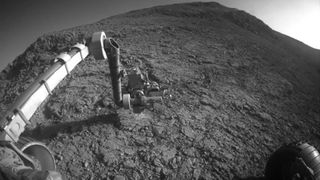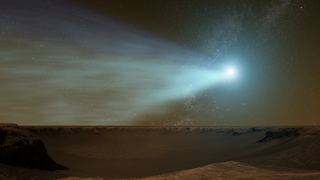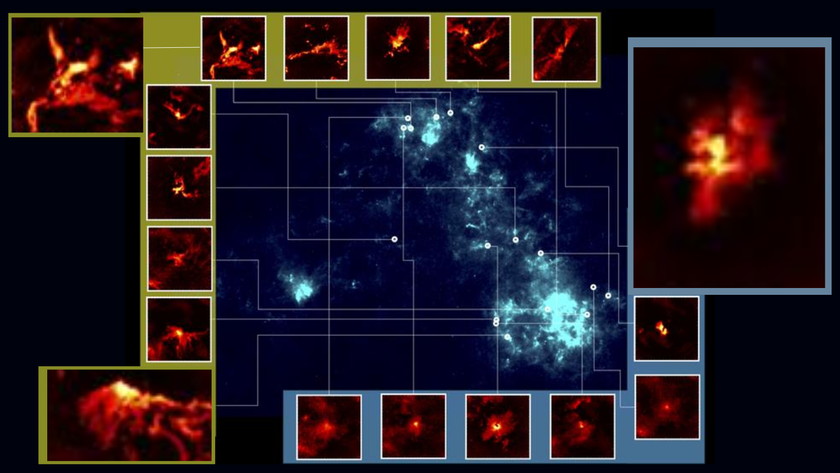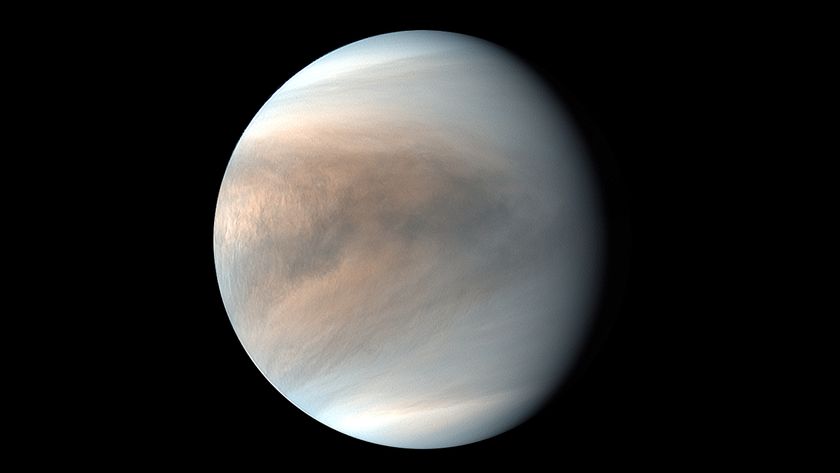Did Asteroid Impacts Incubate Mars' Ancient Oceans?

Last year, NASA researchers looked at water in the Red Planet's atmosphere and compared it to water trapped in ancient meteorites from Mars. The research suggested that roughly 87 percent of the water escaped to space. But there's ample evidence out there that Mars was once soaked in water. For example: All three rovers that landed on the surface have found evidence of it in various forms — minerals formed in water, or ancient streambeds.
If an ocean did exist, it would be where the rovers are — in the northern plains, since it is low-lying ground. But how did that water get there in the first place?
PHOTOS: Opportunity's Top 5 Revelations
An emerging hypothesis suggests that a few billion years ago, much of Mars was covered in water ice (similar to the poles of today). The ice likely came from asteroids depositing it on to the surface. Then came an event known as the Late Heavy Bombardment, where asteroid debris pummeled the inner solar system roughly four billion years ago. The asteroids could have melted the Martian ice and created an ocean for as long as 200 million years.
The research comes from Timothy Parker, a research scientist at NASA's Jet Propulsion Laboratory, who has researched the possibility of a past ocean on Mars since the 1980s. That's when the Viking missions were beaming back black-and-white images of Mars at what today would be considered extremely low resolution. Even then, Parker told Discovery News, he could see what he described as "wave-refracted shorelines" in the northern plains of Mars, shorelines that appeared similar to what is on Earth.
NEWS: Mars Pebbles Carried for Miles by River
As better, more high-resolution data arrived in the 1990s and beyond, Parker noticed something odd. The supposed Martian ocean interiors are lower than the shorelines. This is opposite to what happened on Earth, when isostatic rebound (the ground rising up after large icebergs melt) made the interiors higher than the shorelines. What accounted for the mystery?
Get the Space.com Newsletter
Breaking space news, the latest updates on rocket launches, skywatching events and more!

ANALYSIS: Curiosity Has Hit a Martian Mineral Jackpot
Parker suggests that Mars did not natively have an ocean — it was too far from the sun and its atmosphere, even back then, was quite thin. Instead, he suggests that Mars was an ice-covered planet. The sulfates came from meteorites that hit the surface and temporarily melted the ice, forming a shallow pool of water.
"Once the Late Heavy Bombardment ceased, the ocean regressed and froze over," Parker said. That would explain the shorelines staying depressed, because the resulting ice didn’t evaporate rapidly as what was seen on Earth after ice ages; instead, it slowly sublimated into the Martian atmosphere.
He also pointed out that such an ocean would have been covered in debris and ice. At the shorelines, it would create channels that look like they were carved by thick lava (an alternate explanation for possibly water-carved channels on Mars).
PHOTOS: When Liquid Water Gushes on Mars

Parker believes that Opportunity is driving on an ocean lakebed because of the number of large polygonal cracks it has encountered (implying massive evaporation). Also, some parts of Endeavour Crater (its current roving grounds) have damage, scour marks and the like that suggest ice being pushed around in vast quantities by water and hitting the shoreline. But his hypothesis is not universally accepted by the team, he added.
ANALYSIS: Mars Water: Follow the Toxic Stream to Find Alien Life
Another explanation for a liquid ocean could be the planet gradually outgassing volatiles through volcanism, but this depends on factors such as how thick the atmosphere was on Mars and how much sunlight the sun had to warm the planet. The general consensus was the young sun only had 70 percent the strength of the current one, so Parker said he isn't sure this alternate hypothesis is viable.
Parker presented his research at the Lunar and Planetary Science Conference in Texas in March. He said his goal is to get some discussion from the community, and to begin correlating the work with results from other missions such as NASA’s orbital MAVEN (Mars Atmosphere and Volatile Evolution) mission, which is investigating the mysteries of Mars’ thin atmosphere.
Originally published on Discovery News.
Join our Space Forums to keep talking space on the latest missions, night sky and more! And if you have a news tip, correction or comment, let us know at: community@space.com.

Elizabeth Howell (she/her), Ph.D., was a staff writer in the spaceflight channel between 2022 and 2024 specializing in Canadian space news. She was contributing writer for Space.com for 10 years from 2012 to 2024. Elizabeth's reporting includes multiple exclusives with the White House, leading world coverage about a lost-and-found space tomato on the International Space Station, witnessing five human spaceflight launches on two continents, flying parabolic, working inside a spacesuit, and participating in a simulated Mars mission. Her latest book, "Why Am I Taller?" (ECW Press, 2022) is co-written with astronaut Dave Williams.


